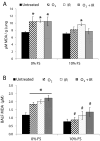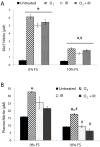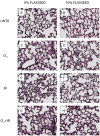Flaxseed Mitigates Acute Oxidative Lung Damage in a Mouse Model of Repeated Radiation and Hyperoxia Exposure Associated with Space Exploration
- PMID: 25705570
- PMCID: PMC4333641
- DOI: 10.4172/2161-105X.1000215
Flaxseed Mitigates Acute Oxidative Lung Damage in a Mouse Model of Repeated Radiation and Hyperoxia Exposure Associated with Space Exploration
Abstract
Background: Spaceflight missions may require crewmembers to conduct extravehicular activities (EVA). Pre-breathe protocols in preparation for an EVA entail 100% hyperoxia exposure that may last for a few hours and be repeated 2-3 times weekly. Each EVA is associated with additional challenges such as low levels of total body cosmic/galactic radiation exposure that may present a threat to crewmember health. We have developed a mouse model of total body radiation and hyperoxia exposure and identified acute damage of lung tissues. In the current study we evaluated the usefulness of dietary flaxseed (FS) as a countermeasure agent for such double-hit exposures.
Methods: We evaluated lung tissue changes 2 weeks post-initiation of exposure challenges. Mouse cohorts (n=5/group) were pre-fed diets containing either 0% FS or 10% FS for 3 weeks and exposed to: a) normoxia (Untreated); b) >95% O2 (O2); c) 0.25Gy single fraction gamma radiation (IR); or d) a combination of O2 and IR (O2+IR) 3 times per week for 2 consecutive weeks, where 8-hour hyperoxia treatments were spanned by normoxic intervals.
Results: At 2 weeks post challenge, while control-diet fed mice developed significant lung injury and inflammation across all challenges, FS protected lung tissues by decreasing bronchoalveolar lavage fluid (BALF) neutrophils (p<0.003) and protein levels, oxidative tissue damage, as determined by levels of malondialdehyde (MDA) (p<0.008) and nitrosative stress as determined by nitrite levels. Lung hydroxyproline levels, a measure of lung fibrosis, were significantly elevated in mice fed 0% FS (p<0.01) and exposed to hyperoxia/radiation or the combination treatment, but not in FS-fed mice. FS also decreased levels of a pro-inflammatory, pro-fibrogenic cytokine (TGF-β1) gene expression levels in lung.
Conclusion: Flaxseed mitigated adverse effects in lung of repeat exposures to radiation/hyperoxia. This data will provide useful information in the design of countermeasures to early tissue oxidative damage associated with space exploration.
Keywords: Acute lung injury; Bronchoalveolar lavage; Double-hit; Hyperoxia; Inflammation; Lung fibrosis; Mouse model; Nitrosative stress; Oxidative stress; Radiation pneumonopathy; Space exploration; TGF-β1; Total body irradiation; extravehicular activity.
Figures







Similar articles
-
Oxidative Lung Damage Resulting from Repeated Exposure to Radiation and Hyperoxia Associated with Space Exploration.J Pulm Respir Med. 2013 Sep 30;3(5):1000158. J Pulm Respir Med. 2013. PMID: 24358450 Free PMC article.
-
Novel Double-Hit Model of Radiation and Hyperoxia-Induced Oxidative Cell Damage Relevant to Space Travel.Int J Mol Sci. 2016 Jun 16;17(6):953. doi: 10.3390/ijms17060953. Int J Mol Sci. 2016. PMID: 27322243 Free PMC article.
-
Dietary flaxseed administered post thoracic radiation treatment improves survival and mitigates radiation-induced pneumonopathy in mice.BMC Cancer. 2011 Jun 24;11:269. doi: 10.1186/1471-2407-11-269. BMC Cancer. 2011. PMID: 21702963 Free PMC article.
-
Radiation mitigating properties of the lignan component in flaxseed.BMC Cancer. 2013 Apr 4;13:179. doi: 10.1186/1471-2407-13-179. BMC Cancer. 2013. PMID: 23557217 Free PMC article.
-
Dietary flaxseed prevents radiation-induced oxidative lung damage, inflammation and fibrosis in a mouse model of thoracic radiation injury.Cancer Biol Ther. 2009 Jan;8(1):47-53. doi: 10.4161/cbt.8.1.7092. Epub 2009 Jan 1. Cancer Biol Ther. 2009. PMID: 18981722 Free PMC article.
Cited by
-
Copper Oxide Nanoparticle-Induced Acute Inflammatory Response and Injury in Murine Lung Is Ameliorated by Synthetic Secoisolariciresinol Diglucoside (LGM2605).Int J Mol Sci. 2021 Aug 31;22(17):9477. doi: 10.3390/ijms22179477. Int J Mol Sci. 2021. PMID: 34502389 Free PMC article.
-
Flaxseed lignans enriched in secoisolariciresinol diglucoside prevent acute asbestos-induced peritoneal inflammation in mice.Carcinogenesis. 2016 Feb;37(2):177-87. doi: 10.1093/carcin/bgv174. Epub 2015 Dec 17. Carcinogenesis. 2016. PMID: 26678224 Free PMC article.
-
Study logistics that can impact medical countermeasure efficacy testing in mouse models of radiation injury.Int J Radiat Biol. 2021;97(sup1):S151-S167. doi: 10.1080/09553002.2020.1820599. Epub 2020 Sep 24. Int J Radiat Biol. 2021. PMID: 32909878 Free PMC article.
-
Effects of sevoflurane preconditioning on lung injury during one lung ventilation.Int J Clin Exp Med. 2015 Aug 15;8(8):13634-8. eCollection 2015. Int J Clin Exp Med. 2015. PMID: 26550306 Free PMC article.
-
Late Inflammation Induced by Asbestiform Fibers in Mice Is Ameliorated by a Small Molecule Synthetic Lignan.Int J Mol Sci. 2021 Oct 12;22(20):10982. doi: 10.3390/ijms222010982. Int J Mol Sci. 2021. PMID: 34681644 Free PMC article.
References
-
- Prisk GK. The lung in space. Clin Chest Med. 2005;26:415–438. vi. - PubMed
-
- Hu S, Kim MH, McClellan GE, Cucinotta FA. Modeling the acute health effects of astronauts from exposure to large solar particle events. Health Phys. 2009;96:465–476. - PubMed
-
- Townsend LW. Implications of the space radiation environment for human exploration in deep space. Radiat Prot Dosimetry. 2005;115:44–50. - PubMed
-
- Holloway RJ, Leong GF, Ainsworth EJ, Albright ML, Baum SJ. Recovery from radiation injury in the hamster as evaluated by the split-dose technique. USNRDL-TR-1111. Res Dev Tech Rep 1967 - PubMed
-
- Leong GF, Page NP, Ainsworth EJ, Hanks GE. Injury accumulation in sheep during protracted gamma radiation. USNRDL-TR-998. Res Dev Tech Rep 1966 - PubMed
Grants and funding
LinkOut - more resources
Full Text Sources
Other Literature Sources
